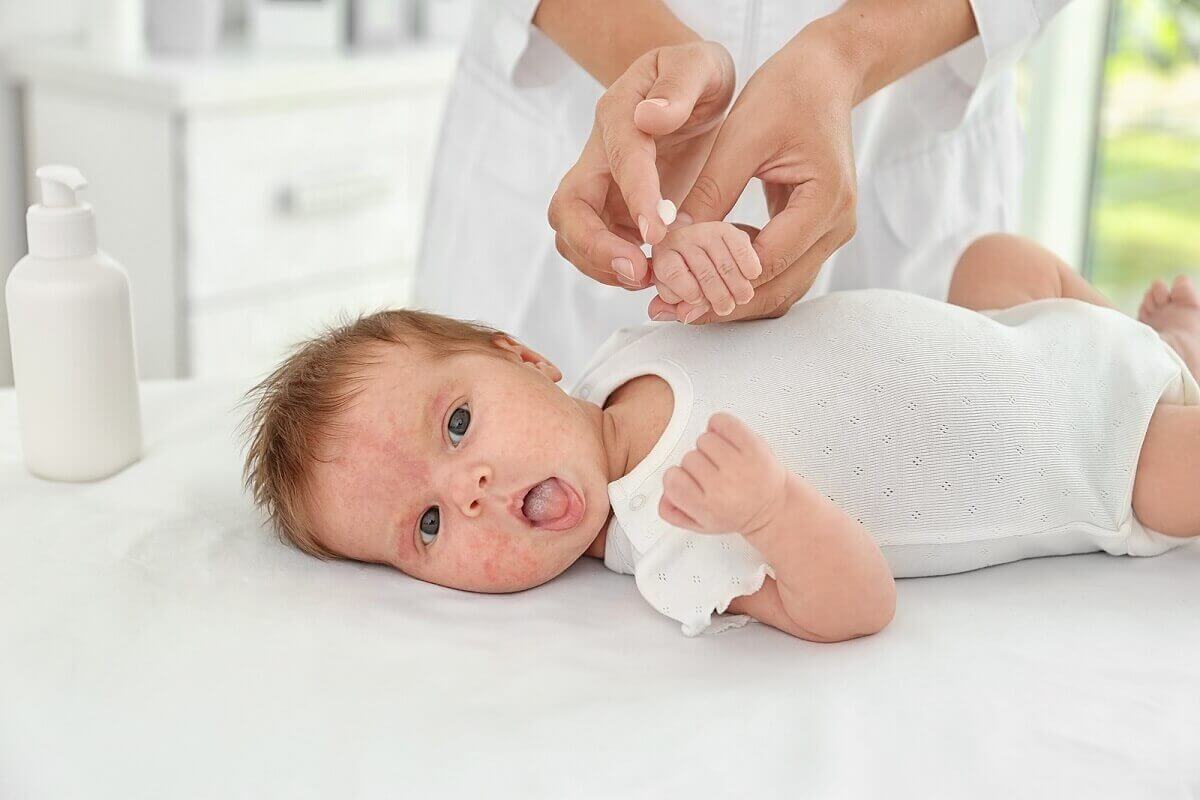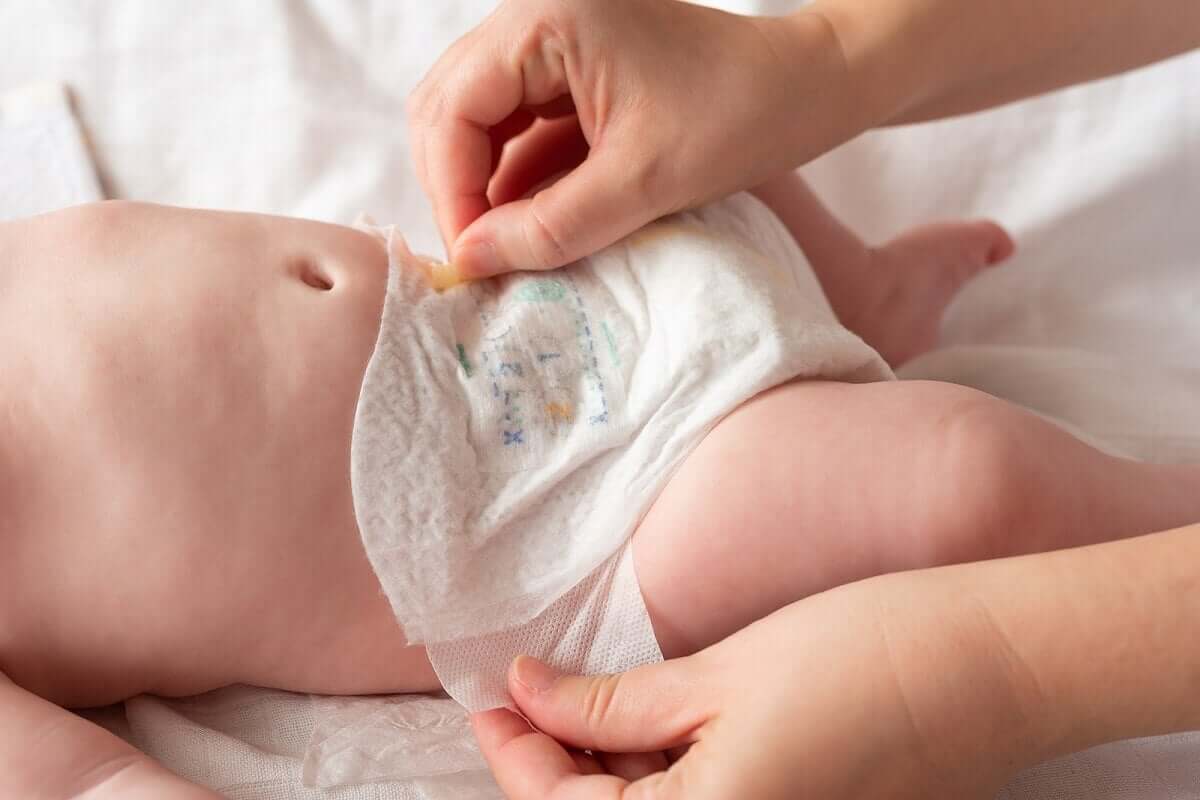Important Aspects of Newborn Baby Skin Care


Written and verified by the dermatologist Maria del Carmen Hernandez
Knowing newborn baby skin care is crucial for all parents. As the skin of healthy babies forms a resistant barrier, it continues to develop for at least the first year of life.
Consequently, the susceptibility to dryness and irritation from external factors is higher than at other ages. Because of this, too much heat or cold can trigger allergic reactions. Certain products can even have an aggressive reaction.
Keep reading to find out more about newborn baby skin care.
Newborn baby skin care
In the first place, it’s essential that baby cleaners and moisturizers are well-tolerated and don’t alter the stratum corneum (the outermost layer of the epidermis). After birth, the skin is sensitive and exposed to factors that can cause the skin barrier to break down.
This includes the following:
- Saliva
- Nasal secretions
- Urine
- Feces (including fecal enzymes)
- Dirt
Due to daily exposure to these factors, it’s essential to ensure optimal skin cleansing and adequate protection of the baby’s skin barrier. To do this, we recommend that you put into practice the principles that we’re going to detail below.
Newborn baby skin care: Hygiene
A newborn baby’s skin hygiene should start when their body temperature is stabilized. At birth, the pH of the skin is neutral. Later, it becomes acidic.
The use of alkaline soaps causes a transitory increase in the pH and predisposes the baby to infection and irritation. For this reason, neutral or low-acid, unscented soaps are recommended in minimal doses.
During the first two weeks, wash your baby gently and only with warm water. Excessive temperature, heavy use of soaps, and overly frequent or lengthy baths, among other things, contribute to dry skin (irritative dermatitis), according to studies by Pediatric Dermatology.

Temperature
To ensure good skin care for babies, you must consider the temperature of the baby’s surroundings. This is because when the temperature is too high, it can lead to the appearance of sweat or hyperthermia. Meanwhile, if it’s too cold, it can lead to hypothermia or panniculitis.
This is why you’ll need to ensure adequate protection against temperature changes, especially in summer and winter. According to the information given by the American Academy of Pediatrics, babies under six months of age should be kept out of direct sunlight as much as possible.
You may be interested: The Importance of Summer Skin Care for Children
Antiseptic solutions
The use of products containing antiseptics for the cleaning of healthy skin is not guaranteed. This is because it causes the alteration of the cutaneous microbiological ecosystem and contributes to the proliferation of other types of microorganisms.
Also, the skin can easily absorb the alcohol and can cause burns or changes in the skin’s pH.
Moisturizers
Moisturizers can be used as part of a newborn baby’s skin care. However, this is only long as they have the correct formula for use on babies. Then, they can help to improve the skin’s protective barrier after bathing. It’s even advisable to consider using them twice a week.
To avoid occlusive effects, the ideal thing is to apply a thin layer to avoid trapping residue in the folds of the skin. Otherwise, as detailed in a publication in The Journal of Investigative Dermatology, thermal deregulation, and bacterial colonization may occur.
Navel care
The stump of the umbilical cord usually falls off any time between 5 and 15 days after birth. This can be considered a wound and, because of that, a possible gateway for germs.
Therefore, you should keep the stump dry and clean, with no gauze or protection around it. It’s also advisable to wear loose clothing and to avoid covering the umbilical region with the diaper. In this case, the use of an antiseptic agent is recommended and you should apply it at every diaper change.
Care of the skin in the diaper area
Diaper rash is common and affects most babies at least once. The enclosed environment of the diaper harbors a complex interaction of factors with harmful potential. In this regard, a publication in the Indian Journal of Pediatrics highlights the importance of keeping the area clean and dry.
When moisture is retained for a long time in the diaper, friction increases. As a result, skin macerations occur, as well as more permeability and microbial growth.

Why not take a look at this article: Basic Care for Atopic Dermatitis in Babies
A summary regarding newborn baby skin care
A newborn baby’s skin is more delicate because it hasn’t fully developed its protective barrier. Because of this, it’s essential to carry out cleaning with the utmost hygiene and to make sure you’re using the most suitable products.
To summarize, then, you have a responsibility to take care of the health of your baby’s skin and reduce the risk of allergic reactions or infections. Also, you’ll need to consider aspects such as temperature and the appropriate use of antiseptics and moisturizers.
All cited sources were thoroughly reviewed by our team to ensure their quality, reliability, currency, and validity. The bibliography of this article was considered reliable and of academic or scientific accuracy.
- Oranges T, Dini V, Romanelli M. Skin Physiology of the Neonate and Infant: Clinical Implications. Adv Wound Care (New Rochelle). 2015;4(10):587-595. doi:10.1089/wound.2015.0642
- Gelmetti C. Skin cleansing in children. J Eur Acad Dermatol Venereol. 2001;15 Suppl 1:12-15. doi:10.1046/j.0926-9959.2001.00003.x
- Blume-Peytavi U, Lavender T, Jenerowicz D, et al. Recommendations from a European Roundtable Meeting on Best Practice Healthy Infant Skin Care. Pediatr Dermatol. 2016;33(3):311-321. doi:10.1111/pde.12819
- Blume-Peytavi, Ulrike et al. “Recommendations from a European Roundtable Meeting on Best Practice Healthy Infant Skin Care.” Pediatric dermatology vol. 33,3 (2016): 311-21. doi:10.1111/pde.12819
- Willis I. The effects of prolonged water exposure on human skin. J Invest Dermatol. 1973;60(3):166-171. doi:10.1111/1523-1747.ep12682082
- Jindal AK, Gupta A, Vinay K, Bishnoi A. Sun Exposure in Children: Balancing the Benefits and Harms. Indian Dermatol Online J. 2020;11(1):94-98. Published 2020 Jan 13. doi:10.4103/idoj.IDOJ_206_19
This text is provided for informational purposes only and does not replace consultation with a professional. If in doubt, consult your specialist.








